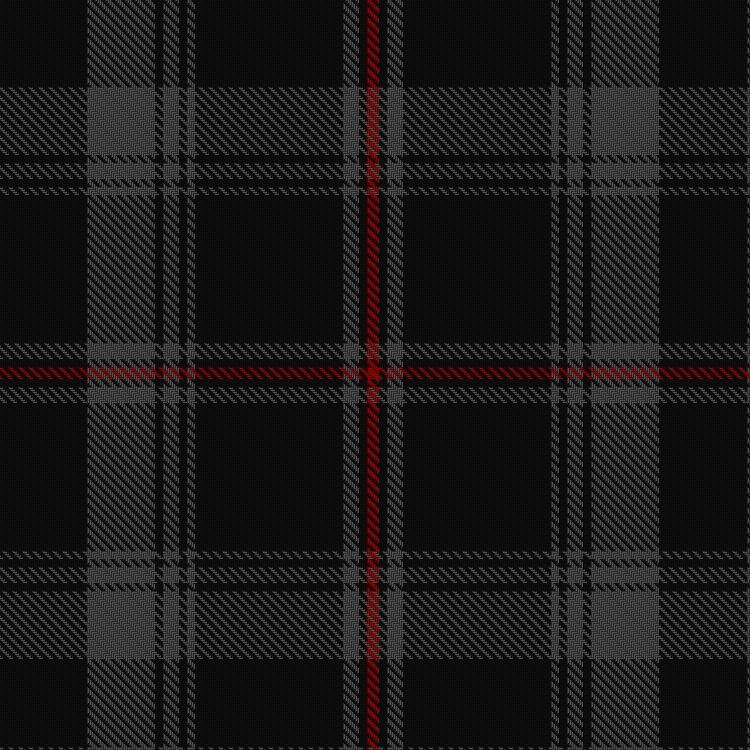Click the tartan to view its entry in The Scottish Registers of Tartans which includes registration details, restrictions, and registrant information.
Unregistered tartans may link to one of the web's online design environments for similar information.
For any questions about reproduction of designs or weaving of these tartans, please contact the registrant directly or via this website.
Witches' Night Out
"Double, double toil and trouble;
Fire burn and caldron bubble."
~ Song of the Witches, MacBeth, William Shakespeare, (c. 1603-1607)
This tartan, inspired by Stratford Festival's 2016 production of William Shakespeare’s Macbeth, was crafted to mark global celebrations of the playwright’s lasting legacy, commemorated 400 years after his death in 1616. The design draws from Macbeth's vivid imagery of blood and shadowed nights, with a dramatic palette of red and black. A charcoal tone, delicately poised between black and white, captures the moral and literal haze of a world in which, as the Weird Sisters ominously declare, “Fair is foul, and foul is fair.” In keeping with theatrical superstition, uttering "Macbeth" inside a theater, except as required by script, is thought to bring calamity. Many actors refer to the title character as the "Scottish King" or "Scottish Lord" and steer clear of quoting lines, especially the witches' spells, before performances. Should anyone accidentally mention Macbeth by name, tradition insists they exit the theater, spin around three times, spit, curse, and knock to be readmitted. Outside the theater or after a performance, however, the play may be spoken of freely. Myth has it that Macbeth’s Hillock, near Brodie in Scotland, is where Macbeth first encountered the witches—those sinister Wayward Sisters who conjure “a charm of powerful trouble.” 🖤 ❤️ 🖤 🧙♀️ 🧙♀️ 🧙♀️
Shakespeare's witches are prophets who hail Macbeth, the general, early in the play, and prophesy his ascent to king. Upon killing King Duncan and ascending the throne of Scotland, Macbeth hears them ambiguously prophesy his eventual downfall. The darkly contradictory witches, their "filthy" trappings and supernatural activities, all set the ominous tone for the play.
Shakespeare's creation of the Three Witches may have also been influenced by an anti-witchcraft law passed by King James nine years previously, a law that was to stay untouched for over 130 years. Macbeth's Hillock near Brodie, between Forres and Nairn in Scotland, has long been identified as the mythical meeting place of Macbeth and the witches. And traditionally, Forres is believed to have been the home of both Duncan and Macbeth.
Inspired by Stratford Festival's 2016 production of William Shakespeare's Macbeth, this tartan was created to coincide with worldwide celebrations of the playwright's enduring legacy, 400 years after his death in 1616.
As described by the designer:
"Macbeth abounds in images of blood and the darkness of night, hence the tartan's striking use of red and black. The charcoal tone, equivocating between the polar opposites of black and white, evokes both the literal and moral fog of an uncanny world in which, as the Weird Sisters (or witches) proclaim, 'Fair is foul, and foul is fair.'"
In theatrical circles, there are several superstitions regarding Shakespeare's Macbeth. The play is said to be cursed, so actors avoid saying its name when in the theatre (the euphemism "The Scottish Play" is used instead). Actors also avoid even quoting the lines from Macbeth before performances, particularly the witches' incantations. Outside a theatre and after a performance, the play can be spoken of openly. If an actor speaks the name "Macbeth" in a theatre prior to one of the performances, he or she is required to leave the theatre building, spin around three times, spit, curse, and then knock to be allowed back in!
For the text of Macbeth's meeting with the witches including the entire witches' brew recipe from Act IV, Scene 1, click the Weird Sisters painting by "Fionacreates."







